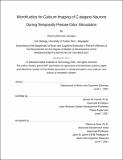Microfluidics for Calcium Imaging of C.elegans Neurons During Temporally Precise Odor Stimulation
Author(s)
Sánchez-Jáuregui, Paloma
DownloadThesis PDF (23.83Mb)
Advisor
Flavell, Steven W.
Terms of use
Metadata
Show full item recordAbstract
How neurons process sensory stimuli to give rise to different behaviors is one of the most pursued and complex questions in neuroscience. With recent technologies, scientists have been able to map how sensory cues, like odors, are represented in the brain. However, it has been proven difficult to study how the processing of sensory information through neural circuits changes with experience. Moreover, due to the complexity of the brain, it is challenging to study how sensory information travels through layers of processing neurons to produce motor responses. But before attempting to solve the difficult task, we need a high-throughput technique that will enable us to localize sites of plasticity in the brain as information about the environment travels through the distinct layers. In this thesis, I provide a protocol for high-throughput calcium imaging in C.elegans. I used the nematode worm, C.elegans as a model system for several reasons: (1) odor-evoked responses have been well characterized, both at the neural and behavioral level1, (2) scientists have mapped out all of the 302 neurons and connections between these and more importantly, (3) due to the small nervous system, scientists can do calcium imaging in freely behaving animals at single-cell resolution. Follow-up studies should aim to map out neural responses to different odors and study how these responses change with experience.
Date issued
2021-09Department
Massachusetts Institute of Technology. Department of Brain and Cognitive SciencesPublisher
Massachusetts Institute of Technology